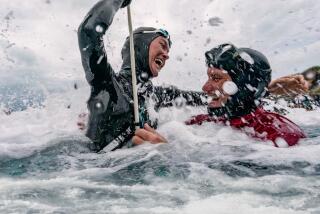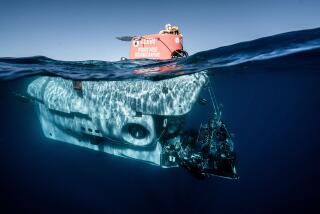ANOTHER WAY TO SEE THE WORLD
- Share via
The call came at 8 a.m. June 2 for 22-year-old Joe Lilly.
Could he be at the Port Hueneme pier in seven hours, with rain gear, diving gear and a few tools, for a two-month (or longer) ocean expedition? A marine research vessel needed a top-notch diving technologist for its journey to New Orleans via the Panama Canal, after which it would set sail for a job site in Alaska.
Lilly, who had just graduated from Santa Barbara City College’s marine diving technology program, didn’t hesitate. He packed his bags, notified his roommates, made storage arrangements for his belongings, then headed for the docks.
“They say in this business, ‘You gotta make yourself liquid,’ ” said Lilly, just two hours before he departed for his first marine technician’s job. “It’s better not to have too many ties or to set up a home base right away. I mean, if I had ties or was in a relationship . . . “ He paused for a minute. “Well, leaving like this would be kind of rough.”
The college is the only public school in America that offers an associate’s degree in marine diving technology. The program is not for everyone; only the most adventurous, dedicated and self-assured sea lovers need apply.
Every year candidates from all over the world arrive at the school’s marine diving facility to begin a grueling two-year program that leads to certification in recreational or commercial diving and jobs that can pay, after only two years of experience, more than $40,000 a year at locations throughout the world.
According to Don Barthelmess, the program’s director, his graduating students’ hiring rate is nearly 100%.
“In fact, there are more job openings than graduates,” he said.
Students who have chosen recreational diving as their emphasis typically find employment as diving supervisors aboard cruise ships and at resorts, as professional diving instructors at private diving schools and as divers for scientific aquatic expeditions. Jobs may take them to such exotic locations as the Arctic Circle, the Great Barrier Reef, the nuclear bomb craters of the Marshall Islands or the warm waters of the Caribbean.
One Santa Barbara City College recreational diving graduate teaches diving to passengers on Royal Caribbean Cruise Lines; six others are “toiling away” as diving instructors at Club Meds in the French West Indies, Bahamas, French Polynesia and Mexico.
The commercial diving program at the college is challenging, and its graduates are in demand. After being trained in disciplines such as hyperbaric chamber operation, bell diving, remotely operated vehicle use, underwater welding, life support system maintenance and surface-supplied diving, graduates are able to find work repairing transatlantic cables, operating diving bells, working on offshore oil platforms, doing underwater inspection, mapping the ocean floor, operating submersible crafts and performing intricate salvage operations.
The college’s commercial diving alumni have explored the famous wreck of the Edmund Fitzgerald in Lake Superior, performed critical salvage work in the Atlantic Ocean after the 1986 space shuttle Challenger disaster and, most recently, aided federal investigators in recovering underwater debris from the TWA Flight 800 explosion last year off Long Island, N.Y.
Many of the school’s former commercial diving students have been recruited by America’s top oil companies to work at their burgeoning Gulf of Mexico operations. Still other grads have accepted jobs with marine construction and contracting firms, performing diving work at harbors, lakes, rivers, dams and even containment ponds at chemical and atomic production facilities.
One reason there are so many openings is because commercial diving is so demanding, said employer Chuck Ebner, Western regional manager of Houston-based Oceaneering International Inc.
“There’s definitely a shortage of experienced divers, because once the guys get out of school and into the industry, their attrition rate is phenomenal,” Ebner said. “The work is extremely hard.”
Early attrition is often linked to entry-level pay comparable to fast-food restaurants’ wages. Deckhands may earn $6.50 an hour while they are being trained; beginning remote-vehicle technicians might garner $12 an hour but could be guaranteed daily overtime. Neophyte offshore workers are guaranteed $100 a day in take-home pay.
Incomes can quickly rise once graduates have gotten industry experience under their belts. One 1994 graduate earned more than $100,000 last year working on Shasta Dam in Northern California. Experienced saturation-diving life-support technicians, who spend 28 days at a time in an undersea chamber, earn $1,400 a day.
Getting accepted into Santa Barbara City College’s marine diving program is unlike applying to other community college programs. First, candidates must undergo an extremely extensive physical exam. Anyone who has a condition that could be exacerbated by underwater pressure and air changes is disqualified.
“Safety is the most important component of this program,” said Barthelmess, adding that in the department’s nearly 20-year history, it has recorded only one serious accident--a death in 1972 during an offshore dive, possibly because of a seizure.
Incoming students are subjected to periodic and mandatory drug tests. They are also required to pass a series of tests that include swimming 75 feet underwater without surfacing, swimming 1,000 feet in less than 10 minutes, treading water for 10 minutes and “rescuing” a swimmer by carrying him 75 feet across the water’s surface.
Currently, 105 students are enrolled; the average student is male, about 24 years old. But older returning students and women are entering the marine diving program in growing numbers.
One recent graduate, 23-year-old Jennifer Edwards, who majored in recreational and commercial diving, is now a co-pilot for Atlantis Submarines in Maui, Hawaii. The company, which operates the largest fleet of tourist submarines in the world, hired Edwards the month she graduated. Today, she takes vacationers 120 feet below Hawaiian waters and points out reef fish, endangered corals and, occasionally, humpbacked whales and sharks.
“It’s an amazing job--I’m doing what I love, and I get to live in Hawaii,” she said. Before entering the college’s marine diving technology program, Edwards tried computer engineering, environmental technology and welding.
“But then I saw a brochure for SBCC’s underwater welding. I started the program, and I was hooked,” she says.
While holding down two jobs, Edwards took both recreational and commercial diving classes “to make myself more salable,” and carried heavy course loads so she could graduate in 1 1/2 years.
“I was the only girl in my classes,” she says. “At first, some of the guys checked me out, but, by the end, it was like I had 20 older brothers. There was a line I drew, and they never stepped over it.”
Edwards expects to attain pilot status at Atlantis soon--a promotion that not only will garner her about $50,000 a year in salary, but also might enable her to see more of the world by permitting her to obtain a transfer to one of Atlantis’ other locations in Guam, the Bahamas, Aruba, Cayman Islands, Barbados, St. Thomas, Malaysia or Cancun, Mexico.
Her advice to students considering a career in marine diving technology?
“Make sure you love it,” she said, adding that potential students will be required to pass challenging mathematics, physics, drafting and electronics courses and will be called upon to demonstrate proficient mechanical and fitness skills.
“Try it for a semester. Make sure you’re really committed. Because you’re going to put in a lot of time and expense,” she says.
Accepted newcomers are first trained in a pool, until they prove their competency at simple diving tasks. Then they are taken out to sea aboard chartered boats for more challenging practice dives.
The school charges $13 a unit for the 60-unit program. Tuition for out-of-state residents is $120 a unit. In contrast, private diving schools charge up to $15,000 a year in tuition. This month, 32 students will graduate from the college’s marine diving technology program, then grab their wetsuits and flippers and head for the open seas.
More to Read
Sign up for The Wild
We’ll help you find the best places to hike, bike and run, as well as the perfect silent spots for meditation and yoga.
You may occasionally receive promotional content from the Los Angeles Times.






